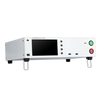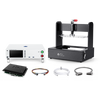Innovating with Tagstand

Analogies are great for explaining new concepts and telling a cohesive story. At the moment, my favorite analogy compares developing a great hardware product to running a marathon. It’s a long and arduous run, but reaching the finish line seems to make the run worth it for everyone who does it.
However, as I mentioned before, it’s even better to finish strong. So when I started my interview with Tim Wang, CEO and founder of Tagstand, I told him about my analogy and asked him, what advice he would give to a hardware developer or hardware entrepreneur looking to finish strong in the product run.
Since we’re both based in Silicon Valley, where nowadays the main focus is software, Tim responded by making comparisons between the differences and similarities between software development and software development. With hardware, “you have to live with the consequences. The investment to build something is much higher [because] you’re moving atoms versus writing bytes, you know the old atoms versus bytes argument. Atoms are real, once you commit work to move atoms around and molecules around to create a physical product, it’s quite an investment.” This big difference between hardware and software development is also a big barrier to expert software developers trying to apply their expertise in the hardware world.
But despite the differences, there is an important step in any product design process. It seems obvious, but “You have to really understand your user and what the need is, and then make sure you focus on the product features that they need. Now, I’m going to borrow a term from the software world, MVP. Minimum viable product. . . You should apply that to the hardware world too. What are the features that will allow your product to basically have a customer--have sales. And then the next iteration, your job is not to fix problems. Of course you’re always going to do that. . . But it’s to tweak the benefits and features of your product, and then potentially add new ones that maybe your MVP didn’t cover. So that’s kind of a long winded answer. But to recap, really understand your customer and the MVP that would satisfy your customers so that you can make money. That’s the kind of lens through which you need to look at it. It’s very difficult from a purely technical point of view to do that. So it’s very important to have a marketing outlook as well before you move it across the finish line.”
By focusing on the idea of an MVP, developers and entrepreneurs have to hone in on their product’s mission and which features complement and support that mission. In Tim’s breakdown of this process, he offers a very methodical approach that requires research and marketing work. This approach contrasts with Lenore and Windell’s (from Evil Mad Scientist) more organic approach that’s driven by an innate understanding of their user base. These two contrasting case studies demonstrate that there are many paths to good marketing. That said, you’re probably a lot more likely to succeed (and scale) when you take the systematic approach that Tim recommends.
Back to the marathon analogy, after explaining the importance of defining an MVP, Tim asserts, “you never really finish, right? You’re always going to be iterating on top of what you’re doing. You’re never going to create the product and that’s it, you’re done. So the finishing strong is, like you said, it’s a marathon. But it’s an endless marathon. So maybe the finishing strong is finishing your first milestone on the run. If using the marathon analogy, your first milestone is the MVP, so finishing strong is selling your product to customers who need it. So you know the upfront work of identifying your customers, requirements, and then the touchy part is filtering it down and trading off because you’re not going to be able to offer everything to everybody. But then you come out with your MVP, and then that will allow you to cross the first milestone. And then you can move on to your next milestone.”
In his answer to my first question, I realized the importance of having both a developer’s mindset as well as an entrepreneurial mindset. Combining both these mindsets, Tim was able to thoroughly position Tagstand for success as an expert provider of unique NFC products. The reason being that, “for NFC, it’s all execution because NFC, the technology, has been around for like 15 - 20 years. It’s not a new technology. What’s new about NFC is that the market can now use it.
Before starting Tagstand, Tim got exposure in the auto ID space heading international sales for a Chinese firm specializing in RFID (Radio Frequency Identification) technology. During that time, he was able to get in-depth exposure to the supply chain and use cases for auto ID technology. Despite RFID being a well-established technology with powerful industrial uses, Tim saw some downsides. “RFID is expensive to implement because the hardware to read RFID is not cheap. With NFC, everybody who has a smartphone--and not iPhone is on board, so iOS is part of that mix--basically all smartphones, that are mid tier or higher can read NFC. So you just opened up the world of applications at a very low cost”
With two engineering degrees (BS from Berkeley and MS from Stanford) as well as an MBA from UCLA, Tim has a special edge as both a technical expert as well as a businessman. In Tim’s words, “we’re not just the middleman. We’re offering a lot of value on product consulting. Yeah, there’s some configuration and development, and we take away the risk of the manufacturing because that’s a whole new world. Finding a supplier and getting that going--it’s a lot of effort that our clients don’t necessarily want to deal with.”
Of course, this also means that Tim does contribute to developing NFC products in a new way. When I asked him to tell me about an exciting project, he gave a vague but inspiring answer:
“One thing [project] that’s still live--I can’t say too much because we’re under NDA, but it’s a new type of tag that can be integrated with a lot of products. And the customer came to us because they had a new application for NFC. But they couldn’t do it themselves, so they wanted to partner with us. So, I know it’s a little bit abstract, I can’t name a lot of specifics, but you know, it’s the, it’s a nice sweet spot. . . they’re interested in partnering on developing a very unique tag that could potentially be used in a lot of different things, and it’s pushing the envelope for us because it’s making us develop something that we’ve never done before.”
The reason why this is a sweet spot, is because there are tougher situations that look appealing at first sight, but realistically expose companies to bigger risks than necessary. It’s easy to get drawn into the idea of working with huge enterprises ready to order millions of units, but “you have to be careful because if they turn it on, and you’re drinking from their fire hose, you can get washed away. . . they’re going to be pushing you down on your cost.” In Tagstand’s case, since they do not own a factory and are more service/quality oriented, giant companies interested only in optimizing for cost per unit are not ideal.
This situation arose a few months ago, when Tagstand, “had another opportunity recently. And again, I can’t name names because we’re under NDA. But let’s just put it this way, it’s kind of related to the issue with vaporizers. Right now, a lot of vaporizers are out there causing problems. So you can imagine they need authentication. As you know, one of the use cases of NFC is authentication. So we had an opportunity to work with a company that’s in that space. And again, they’re a [giant in the industry].”
While the prospective client “had a very unique design that was easy for us to make, and that’s going to be in high volumes--I’m talking to their purchasing team, and they’re pushing me down on cost. So everything about that deal was going the wrong way. Very high volumes, very price sensitive, and the product was very, very specialized. And so those three elements made it into something that was not hitting the sweet spot for Tagstand. And eventually, they went with their existing contract manufacturer and they actually went with a different type of tag that we don’t provide. . .”
Looking back at it now, Tim is glad he bid on it, but even more glad that they didn’t get the case “because it would have been very challenging to make sure we maintain profitability because. . . it was going to expose us to a lot of risk, you know, inventory risk, payment terms, and the kind of payment terms they would want. . . and then, you know, that whole industry now that they’re experiencing so many problems, I’m glad we didn’t get involved with it.“
This last scenario represents a reality that brilliant developers and entrepreneurs sometimes struggle with: knowing which projects are too big to take on. In the startup stratosphere (apt for this topic since we’re based in Silicon Valley), where a startup is by nature designed to expand and grow as quickly as possible, there’s a conflict of interest for hardware startups. Hardware firms generally have to move more carefully with greater precision because the material risks are much higher.
That said, there are many models for success. In my conversation with Tim, I learned about Tagstand’s success and how they reached it. I would say the main takeaways are as follows:
- Do your homework and research your market so you can develop your MVP
- A dual approach (engineering and business) is key to success for hardware firms
- It’s important to know which prospects make good clients and which ones might prove to be difficult
Tim Wang is an expert in the field of auto ID technology and currently splits his time between Silicon Valley and China. If you ever speak with him in-person, you’ll likely be impressed by his eloquence. You can find him on LinkedIn: https://www.linkedin.com/in/tim-w-linked-in/
Thank you Tim, for taking the time to speak with me and telling me about Tagstand’s approach to NFC.
Have questions, comments, concerns, or want to be featured on our blog? Fill out this form!










Leave a comment